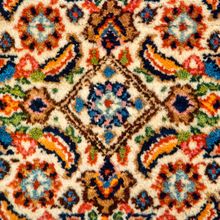Birjand Rug
| Birjand Rug | |
|---|---|
 Design of Birjand Rug (Rugman) | |
| General information | |
| Name | Birjand Rug |
| Original name | قالی بیرجند |
| Alternative name(s) | Birjand Carpet |
| Origin | |
| Category | City |
| Technical information | |
| Common designs | Medallion |
| Common colors | Red, Crimson, Cream, Navy Blue, Beige |
| Dyeing method | Natural, Synthetic |
| Pile material | Wool |
| Foundation material | Cotton |
| Knot type | Asymmetrical (Persian) |
Birjand rugs originate from Birjand. Located in the southern part of the Province of Khorasan, it has a history dating back more than 2000 years. Its population of nearly 120,000 people own approximately 18,000 carpet looms weaving magnificent area rugs reputed to be the finest produced in eastern Iran. The knot style used on Birjand rugs is the Persian asymmetrical knot, due in large part to the fact that area rugs woven with this knot tend to be more accurate and symmetrical. Birjand's rugs are famous and known internationally as "Mood Carpet". Mood is the name of a region in Birjand and the rug weaving style is unique to that region.
History
Bojnurd is a city located in northeastern Iran and was once part of the largest Persian province historically referred to as Greater Khorasan. Bojnurd was formerly called Bijan Gerd. Today Bojnurd is the capital of the North Khorasan Province. The majority of the city's population is of Kurd origin. Historically, Kurd tribes were transferred to this region for political reasons under the Safavids during the late sixteenth century. The Kurds were respected as strong fighters, and the Safavid Empire brought them to defend the northern Persian border against enemies in neighboring countries. During the nineteenth and first half of the twentieth centuries Bojnurd was a city known for trade, importing and exporting to the Turkestan region and to Russia in the north.
Bojnurd rugs are known in the market from the nineteenth century. The rugs have a wool foundation and a wool pile. The Turkish (symmetric) knot is exclusively used. The designs are geometric and are influenced by Baluch and Kurd tribal styles. The Lattice, Mihrab-like (prayer arch), and Shrub designs are made by Bojnurd weavers, and were common among these tribes. A popular Kurd design has one or several lozenge-shaped medallions surrounded by stylized Hook motifs and featuring folk art motifs throughout the field and medallions. In general, older Bojnurd woven rugs are referred to as Kurd Khorasan rugs. The older rugs generally have an extended flatwoven kilim on both ends, which adds a lovely nomadic touch. Bojnurd weavers also made flatwoven rugs with Kurd and Baluch folk art elements. By the late twentieth century some Bojnurd weavers began to make rugs similar to Meshad and other Khorasan weaving cities. These rugs were sold in the Meshad and Tehran markets for domestic use and export.
The coloration is generally strong in appearance, with reds, blues, or ivory woven for the background and borders. In addition to these colors, different shades of brown, gold, and black appear in the design elements and outlines.
Formats vary from small bags to gallery-size rugs approximately twelve feet by six feet. The rugs generally range from low to good in grade quality.[1]
See also
| Search for Birjand Rug on Wikipedia. |
References
- ↑ Moheban, 2015, 106-107
Bibliography
- Abraham Levi Moheban. 2015. The Encyclopedia of Antique Carpets: Twenty-Five Centuries of Weaving. NewYork: Princeton Architectural Press.